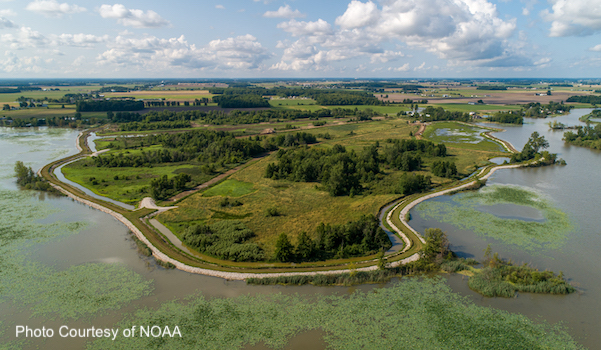 Following an article last fall that summarized progress made on the MAAC-recommended management action (MAP) projects for Beneficial Use Impairment (BUI) 14b (Loss of Wildlife Habitat), we are excited to spotlight another BUI 14b project.
Following an article last fall that summarized progress made on the MAAC-recommended management action (MAP) projects for Beneficial Use Impairment (BUI) 14b (Loss of Wildlife Habitat), we are excited to spotlight another BUI 14b project.
The Toussaint Marsh State Wildlife Area was an existing impounded wetland complex located near the town of Oak Harbor, roughly five miles from Lake Erie. The site is adjacent to the Toussaint River and includes 125 acres of emergent and lowland shrub wetlands within western Lake Erie’s coastal zone. Habitat in this area of Ohio was historically dominated by emergent and forested wetlands. Human activities dramatically altered this landscape, resulting in the loss of more than 90% of the historic wetlands.
The impetus of project work at the Wildlife Area was failure of existing water control management structures necessary to maintain quality wetland habitat. As such, the ultimate goals of this project have been the restoration and redesign of the existing impounded wetland in order to improve the quality of habitat for fish and wildlife in the coastal region of Lake Erie and the restoration of hydrological connections between the wetlands and Toussaint River.
Project work has been phased over a number of years. Phases I and II of the project are complete and Phase III will be completed this summer (2020). Primary management practices have included;
- The removal and replacement of existing water control and pump structures with improved infrastructure;
- The restoration of sections of the external levee; and
- The removal of more than one mile of internal levees.
The new and improved water control/pump infrastructure will allow for use as flow through systems/fish passage if desired, and also increases the efficacy of invasive species management within the wetland. Removal of the internal levees established one large wetland where four small wetland units previously existed, increasing connectivity and diversity of habitat within the wetland. Project partners predict that the creation of a larger and more continuous area will greatly benefit amphibian, reptile (turtles and snakes), and fish species that reside in the area.
This project was a collaborative effort among the Ohio Division of Wildlife, The Nature Conservancy and Ducks Unlimited, with financial support provided by the National Oceanic and Atmospheric Administration, the Great Lakes Fish and Wildlife Restoration Act and the National Fish and Wildlife Foundation through the Great Lakes Restoration Initiative.
